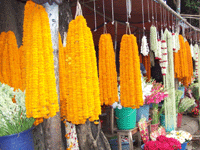Selling flowers by adolescent boys & girls is a common scenario of Dhaka City . Almost everybody may have experienced this stacking in traffic jam. This shows the love of flowers and fragrance as well as a livelihood of some poor family. Indeed Flower business in Dhaka City is booming day by day. This is because Love for flowers is ingrained in almost everybody.
In recent years, it seemed that a revolution had taken place in Dhaka citizen’s attitude towards flowers. A new outlook is evidenced in the widespread interest shown by them, so much so that such interest seems to have become institutionalized.
On the occasions of marriage, birth and wedding anniversaries or, in fact, on any big functions, presentation of flowers has become an established practice.



There are several areas in the city, which bear witness to our new interest in flowers. More conspicuous among them are the Shahbagh and Katabon areas. These are regarded as the hub of the city’s flower market where business worth thousands of taka is conducted every day.
It is understood that sales of flowers as per orders of customers are more profitable than the retail type. And such sales on orders are said to be very considerable. For the paraphernalia of wedding arrangements, such as decoration of the bridegroom’s car, flower arrangements for the bride and decoration of the nuptial chamber, flowers are indispensable. For such purposes, transactions in the flower market are greater in volume.


Previously the space in front of the High Court mazar was the venue of the flower trade. Now it has spread to other specific areas of the city. A little distance away from the Shahbagh road corner towards the west lies the Katabon area where the flower shops outnumber the flower shops in any other area in the city. The neighbourhood around the Mahila Samity theatre venue is embellished by the presence of some flower shops. At present, no statistics are available as to the total number of flower shops that are operating all over the city, besides numerous roadside vendors.
Lately this wide appreciation of flowers forms a new staple of business in the hands of some nondescript youngsters. They can be seen just at the moments shoppers go to board their cars at the end of their shopping or when the rickshaws we travel in get stalled along with cars at road junctions in traffic jams or in the busy shopping areas. These youngsters offer a couple of roses or sticks of Rajanigandha or small garlands of flowers at a small price. This appears to be a sublimated form of begging resorted to by an increasing number of poor boys and girls. They present a poignant spectacle of a grim battle for subsistence at all weathers, fair or foul.
For the Dhaka flower markets, supplies mainly come from Gazipur, Konabari and Savar in the previous greater Dhaka district and also from several villages in Jessore district. In some villages in Jessore district, cultivation of different kinds of flowers for commercial purposes has become a large-scale agricultural industry employing more than a thousand families. The villages engaged in such largescale flower cultivation exceed 20 in number and the people of those villages engaged in such cultivation are reported to earn a level of income which is said to be more than the income level obtained from cultivation of other crops. This is said to be a very encouraging development in improving the village economy.
According to our Export Promotion Bureau, there are bright prospects for earning substantial foreign exchange through export of flowers after meeting the internal needs. At present the turnover in the global flower market is reportedly valued at more than 160 billion dollars. For Bangladesh experts in this line feel there are immense possibilities in this field if cultivation of flowers of different varieties is boosted through special measures and on scientific lines in suitable areas of the country.
In the 2004-05 financial year, the country had earned over Tk 16.61 crore, but it is likely to drop by at least 30 per cent in the current fiscal, the leaders feared.
Although the natural quality like fragrance and colour of indigenous flowers looks fascinating and more natural than the flowers of any other countries like Pakistan , India , and the Netherlands , Bangladeshi growers had no scientific training on how to preserve the flowers.
The growers need training on preservation, germination, disease control, cultivation, and longevity of flowers in order to boost up the export growth, they pointed out.
The growers of India , Kenya , the Netherlands , and Thailand are following the scientific methods in preserving the flowers which have durability of minimum 15 days. But the durability of the country’s flowers is not more than five days.



